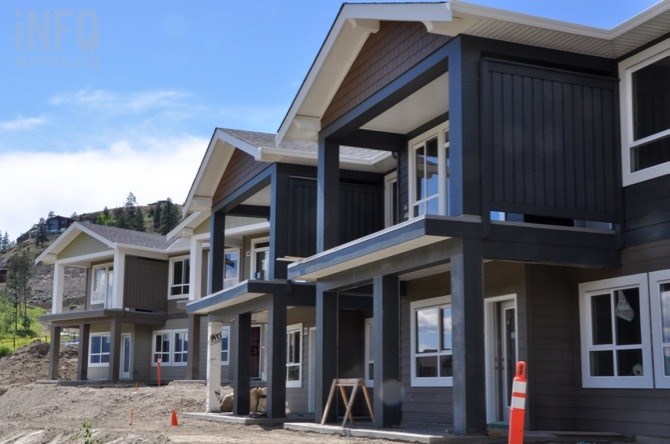10 to 30 per cent of homes in Kamloops, Okanagan are owned by investors
Investors are buying up housing in the Thompson-Okanagan region at a rapidly increasing rate.
Estimates range from 10% to more than 30% of homes in the region are not lived in by the owners and likely owned by corporate investors.
A recent Bank of Canada report called “Housing demand in Canada: A novel approach to classifying mortgaged homebuyers,” found that 19% of homes that were bought in Canada since 2014 are owned by investors.
“The increased presence of investors in the housing market has contributed to strong demand and may reflect a belief that house prices will continue to rise in value,” the report said. “By exacerbating so-called boom-bust cycles in housing markets, investors could thus be a source of instability for the financial system and the economy more broadly.”
They may also be part of the reason that there has been a significant decrease in the number of active listings in the past year as demand has gone up, leading to dramatic increases in prices – in the 30% range year over year in the Thompson and Okanagan.
READ MORE: Okanagan real estate sales increased 25% in 2021
The Bank’s report is based on its review of mortgages taken out at Canadian financial institutions since 2014 and defines investors as homebuyers with multiple mortgaged properties. It does not count those who borrowed money from offshore banks, paid cash or paid off their mortgages.
Statistics Canada publishes data on how many homes are owned by individuals versus non-individuals.
“We recommend that this information be interpreted with caution, as these residential properties could be vacant, rented out, used as a second property, or owned by non-individual entities such as governments or firms,” Stats Canada communication staff cautioned in an email.
That data showed 90% of B.C. homes were owned by individuals in 2020 and 10% by non-individuals but it varies widely by location and time period.
Prior to 1960, non-individuals owned only 4.5% of properties in Kamloops, 4.7% in Vernon, 6.6% in Penticton and 9.6% in Kelowna, according to the Statistics Canada data.
Those percentages fluctuated for each five-year period since then but were mostly in the low single digits. That changed dramatically in the 2016 to 2020 time period.
That saw Vernon’s non-individual rate jump to 14.2% from 2.8%. Penticton went to 15.5% from 6.2% and Kelowna hit 16.9% from 3.9%.
Kamloops went the other way, falling to 17.1% in the 2016 to 2020 time period from 19% for non-individual owners. That 19% had been a jump from 7.2% in 2006-10 and 2.8% in the five years before that.
Another measure is the B.C. Home Owners Grant that is available only for the principal residence of any homeowner.
In 2020, according to Government of B.C. data, it was claimed on 64% of B.C. homes.
That doesn’t necessarily mean that 36% of homes were owned by investors or as investments. The threshold for qualifying for the grant is just under $2 million. That means a few thousand homes in B.C. do not qualify.
The list of the 500 most expensive homes in B.C., put out by B.C. Assessments, only goes down to the $12 million range and the top 100 homes in the Thompson-Okanagan are all worth more than $6 million.
Better Dwellings, which refers to itself as the “largest independent housing news outlet,” did its own dive into Statistics Canada figures and came up with different numbers for what it calls investor-owned properties.
Since 2016, it says, 43.6% of Kelowna homes were bought by investors. That fell to 39.1% in Kamloops, 38.5% in Penticton and 34.1% in Vernon.
“Investor ownership by itself isn’t a good or bad thing, it is what it is,” the report says. “Why investors are purchasing can be an issue, though.”
It puts its own spin on the language in the Bank of Canada report.
“They believe investors are driving up home prices based strictly on the expectation home prices will always rise,” the Better Dwelling report says.
READ MORE: Kelowna city council blames market, not its policies for housing unaffordability
On the plus side, this trend is contributing to an increase in the number of rental properties available.
“We need to do further research to examine the delicate balance between adding to rental supply while removing new builds and resale supply in a housing market that already has supply constraints,” the Bank of Canada report says.
Local realtors, on the other hand, don’t see investor buying as the biggest contributor to the low number of listings and ever increasing prices.
“There are a number of factors keeping listings low in the Okanagan,” Kim Heizmann, president of the Association of Interior Realtors, that will soon include Kamloops, wrote in an email to iNFOnews.ca.
“Investor buying may be a part of it, though probably not as much of a factor in the Okanagan as in Vancouver. More important is that Kelowna led all of B.C. in terms of population growth in 2021 and that growth reflects significant migration from other parts of B.C. to the Okanagan. As a result, those buyers are bringing demand to the region, but no associated supply since they are listing in a different region.”
To contact a reporter for this story, email Rob Munro or call 250-808-0143 or email the editor. You can also submit photos, videos or news tips to the newsroom and be entered to win a monthly prize draw.
We welcome your comments and opinions on our stories but play nice. We won't censor or delete comments unless they contain off-topic statements or links, unnecessary vulgarity, false facts, spam or obviously fake profiles. If you have any concerns about what you see in comments, email the editor in the link above.




